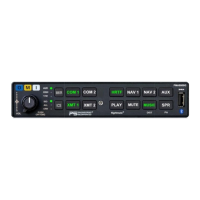PS Engineering
PMA8000G IntelliAudio Audio Selector Panel With flightmate®
Installation and Operator’s Manual
200-890-0912 Page 2-13 Rev. 7, July 2017
2.12 Unit Installation
To install the PMA8000G, gently slide the unit into the mounting rack until the hold-down screw is en-
gaged. While applying gentle pressure to the face of the unit, tighten the 3/32" hex-head in the center of the
unit until it is secure. DO NOT OVER TIGHTEN.
CAUTION
Apply steady pressure to the bezel while screwing the unit into the tray to ensure even seating of the unit
and connectors. WARNING Do not over-tighten the lock down screw while installing the unit in tray. In-
ternal damage will result.
2.13 Operational Checkout
2.13.1 Required Test Equipment
In order to return an aircraft to service after installation of the PMA8000G, the installer must have access to
a Marker Beacon signal generator:
a. IFR NAV401L, NAV402AP, IFR4000
b. TIC T-30D, T-36C
Equivalent test equipment is acceptable as long as the testing requirements can be met.
2.13.2 Audio Panel Test
NOTE
The IntelliVox® is designed for ambient noise levels of 80 dB or above. Therefore some clipping may oc-
cur in a quiet cabin, such as without the engine running, in a hangar. This is normal.
1. Apply power to the aircraft and avionics.
2. Plug headsets into the pilot, copilot, and occupied passenger positions.
3. Verify fail-safe operation by receiving and transmitting on com 1 from the pilot position, with the au-
dio panel power off. The Com audio will be present in one ear cup only.
4. Switch on the unit by pressing the volume (VOL) knob.
5. Check intercom operation.
6. Push the Com 1 XMT select button (lower row).
7. Verify that both of the Com 1 buttons light. Verify that transmit button LED (Light Emitting Diode)
near the mic selector is not blinking unless the radio P-T-T is pressed. If the LED is blinking without
P-T-T, stop testing and troubleshoot the microphone PTT installation.
8. Verify proper transmit and receive operation from the copilot position, noting that the copilot PTT
switch allows proper transmission on the selected transceiver. Verify that the Com 1 Xmt button blinks
when transmitting.
9. Verify that pushing the COM 2 button causes the button to illuminate, and the Com 2 receiver to be
heard. Verify operation on Com 1 from the pilot position.
10. Repeat for Com 2
11. Press and hold the Com 1 Xmt button. While holding the Com 1 button, press the Com 2 Xmt button.
This places the unit in “split Mode;” Verify that the pilot can transmit and receive on Com 1, while the
copilot transmits and receives on Com 2.
12. Verify proper operation of all receiver sources by selecting them using the appropriate button. The
button illuminates to show which source is in use.
13. Push the SPR button. Verify that all selected audio is heard in the cockpit speaker. Verify that the au-
dio mutes when the mic is keyed.
14. Verify that the appropriate LED in the lower button row blinks when either push to talk is keyed.
15. Push both the HRTF button to activate the IntelliAudio™ function. Verify that the audio from COM 1
is present in the 10 o’clock headset position, and COM 2 is present in the 2 o’clock headset position.
16. Verify proper Intercom system operation in the ISO, ALL and CREW modes (see Table 3-1).
17. Verify that the audio selector panel system does not adversely affect any other aircraft system by sys-
tematically switching the unit on and off, while monitoring the other avionics and electrical equipment
on the aircraft.

